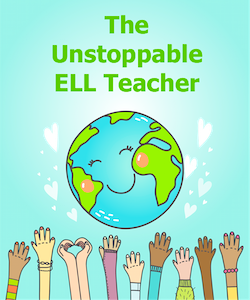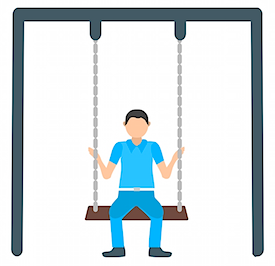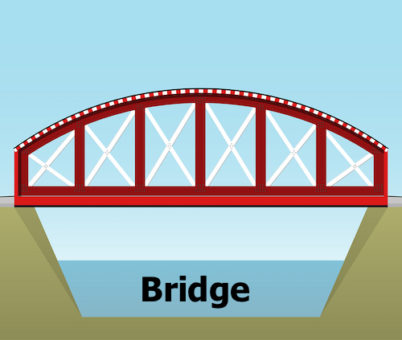ELLs: Try These 5 Scaffolds in Any Subject
A MiddleWeb Blog

You may know them as ELLS, English Learners (ELS) or Multilingual Learners (MLs). However they may be designated in your schools, over the past decade ELLs have been one of the fastest growing groups of students in the United States.
It’s a fresh challenge for many teachers, but we’re used to challenges and we have to prepare ourselves to serve students that come with unique and diverse needs.
ELLs are vastly different from one another. They come with such a wide variety of backgrounds. Some are born here and have limited proficiency in their native language. Others are newcomers who have learned English in their home country but struggle with speaking in English. There are even some who enter our schools with limited or interrupted formal education in their own native language.
Serving a variety of ELLs in a class period is a significant task, but it is not impossible if we embrace a key concept. In order to help ELLs learn content and language simultaneously, we have to make content comprehensible and scaffold instruction.
Scaffolding is a term first used by Wood, Bruner and Ross (1976) as they described conversations between young children and their parents. In construction, scaffolding is a temporary structure put up in the process of manufacturing or repairing a building. Temporary is the key word here. The scaffold is temporary yet it is essential.
When we scaffold our instruction for the students who need it, we can provide necessary support as we promote independence. Scaffolding is future-oriented.
Here are a few easy-to-implement yet highly effective instructional scaffolds that will help to make your lessons ELL-friendly and more comprehensible in any content area.
1. Offer sentence stems

Sentence stems are the push. They help propel language. Many ELLs have the content knowledge in their native language and just need this scaffold to help put the words in motion in English. Offering sentence stems that are tailored to a student’s language level for speaking or writing helps to advance their language.
Here are some examples of sentence stems, by language proficiency level:
Beginner: The ___is___.
Intermediate: I can conclude that ___.
Advanced: Based on___, I can conclude___because…
Advanced High: Based on___, I can conclude___because…In addition…
2. Provide visuals
We’ve probably all heard it said that a picture is worth a thousand words. Pictures are superior! Mountains of evidence exist showing that concepts presented with pictures are more likely to be recalled.
If you do only one of these, this is the one to do. Visuals, in my opinion, are one of the best ways to make content comprehensible to all students but especially for ELLs. Heard information only carries about 10% recall. Adding a visuals lifts recall to 65%! That’s powerful.
Not only is recall improved, but pictures also make content comprehensible and promote academic vocabulary. When an ELL sees a picture along with the words that are spoken or written, they are more likely to understand the language. Many ELLs know the terms in their native language and simply need to translate them into English. Pictures can act as that bridge between the native language and the target language. Pictures provide a type of universal, unspoken language.
3. Allow wait time
Research has proven the amazing results of just 3-5 seconds of wait time. Wait Time 1, as defined by researcher and professor Dr. Mary Budd Row, is the period of time between asking a question and calling on students to answer. Dr. Rowe’s research concluded that 3-5 seconds of Wait Time 1 after asking questions increases students recall, improves the quality of responses and develops student learning while building self-confidence.
Take this for instance . . .
Teacher: Based on the experiment, what can you conclude?
ELL: (listens)
ELL: (translates)
ELL: (processes)

ELL: (builds courage to respond orally)
ELL: (raises hand)
ELL: Based on the experiment, I can conclude that the water evaporated because of the heat applied. (Sentence stems were provided to support the student with this response.)
ELLs need time to listen, translate, process, formulate, build courage, and respond. Wait time is crucial.
Wait Time 2 is the time period after the student responds and the teacher reacts. This wait time allows students to elaborate on their response or complete their answer while the teacher simply nods their head and looks thoughtfully.
Though wait time can seem awkward at first, it does show our students that we not only expect them to answer, we also know they can do it!
4. Slow your speech

Hearing each word clearly helps ELLs capture the word in order to identify it, process it, translate it and comprehend the meaning of the message. This a big job. So avoiding rapid-fire speech helps allow time for ELLs to work through that process.
There is a misconception that speaking loudly helps ELLs. This is not necessarily true. A normal volume will suffice as long as the we don’t talk too fast. Personally, I can empathize with this. I can understand Spanish to a certain degree. But if the speaker begins talking too quickly, I lose all meaning. The rate at which we speak affects how it is received by ELLs.
5. Use gestures
When we use our hands and body, our students that are new to English have a better chance of understanding the messages we are trying to send. This technique is so simple, yet highly effective.
Using gestures can come in various forms. For instance, if I want my students to take out their math book, I can model this and pull out the math book to show the students. When the teacher points to objects and talks at the same time, students are more able to comprehend the lesson. This 5-minute video I put together offers a powerful demonstration of how gestures and other comprehensible input make an impact, even when the language is strange to us.
Another way to use gestures and involve students is to incorporate TPR (total physical response) into vocabulary instruction. TPR is an instructional technique that connects physical movements with critical vocabulary words and their meanings.
This research-based technique, coined by Dr. James Asher, benefits all students and is highly engaging. Take for instance the word “decorate.” The teacher provides a student-friendly definition of the word, and the class works in groups to come up with a physical movement to demonstrate the definition. Watch how third-graders do it in this brief video.
Summing it all up
It’s important to keep in mind that once we put scaffolds in place, they are not permanent. A scaffold is meant to be released once a student no longer needs it. If we don’t release the scaffold, it becomes a crutch. We want our scaffolds to promote independence. Just like when we teach our kids to swing, we give them the initial pushes and teach them the motions. But we won’t be there to push them forever. We have to prepare them to do it on their own.
Instructional scaffolds can be used in all classrooms but are not for every student. Not every ELL will need a scaffold. Being aware of our students’ needs will help us make decisions about the types of scaffolds they need to be successful.
These are just 5 of many scaffolds that can be used across subjects to support ELLs. Feel free to share this post with your colleagues who serve ELLs, and share with us how you scaffold instruction to meet the needs of your ELLs.





































Excellent article! I look forward to sharing this information with my ESOL Teachers and Multicultural Committee Members. Thank you!
How exciting! Thank you for sharing with your colleagues.
Hi, Valentina! These are terrific, classic strategies that all teachers can use to help all students, especially ELs. I really like the visuals associated with each recommendation!
Tan, I am thankful for your constant support and feedback. Meeting you through Twitter has been a gift.
Excellent article my sweet and dear friend! I look forward to sharing this information with my EAL Department. Great job!
Aw, ROY! Thank you! I’m so happy that you found it, read it, and will share! Take care and keep in touch!
Thank you so much for the succinct tips. Looking forward to sharing with core content colleagues.